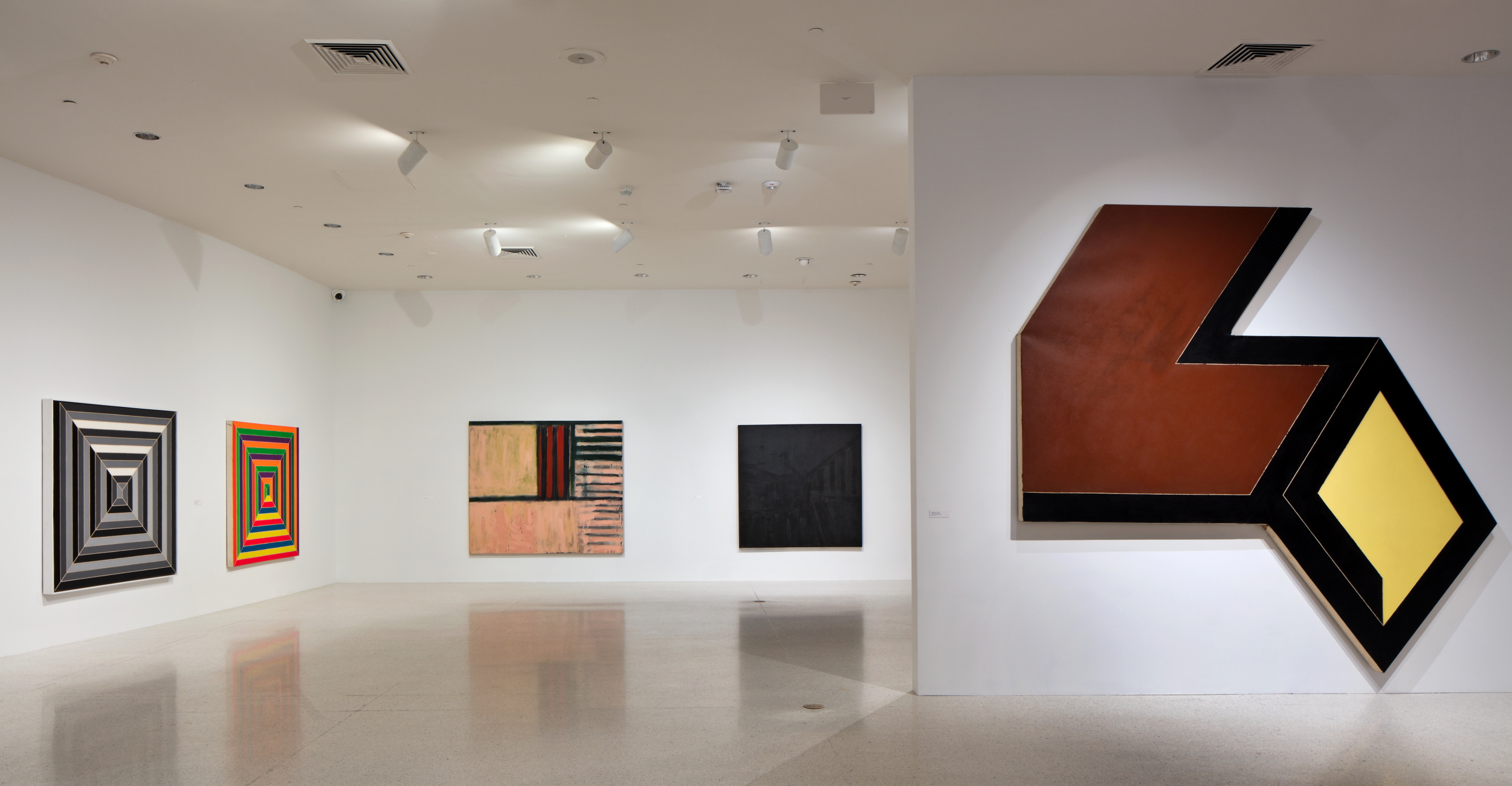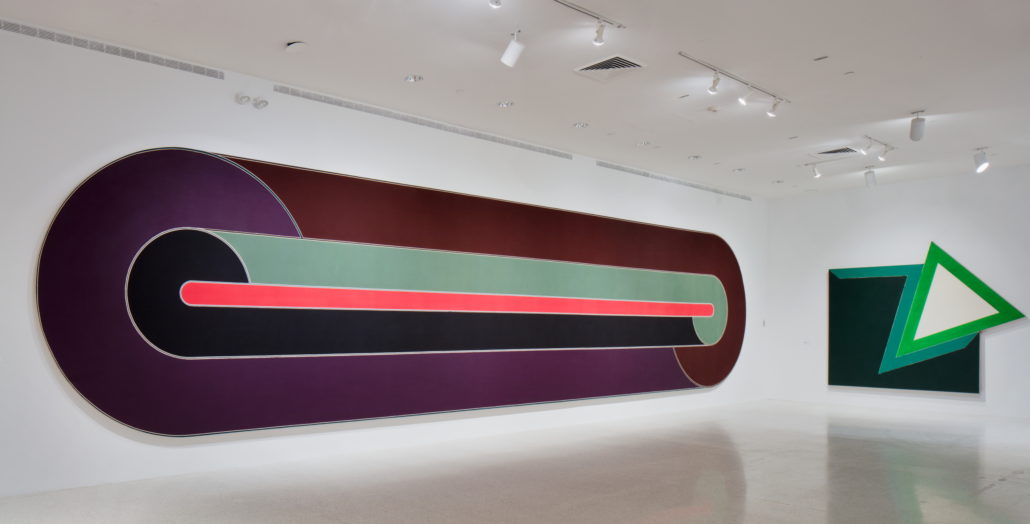- Rust and Blood: A Review of Jennifer Clement’s Gun Love

- In the wildness of daughterhood: Beast Meridian by Vanessa Angélica Villarreal
The Justification of Modernist Painting: A Review of Frank Stella: Experiment and Change
Nathan Timpano
 Installation view of Frank Stella: Experiment and Change at the NSU Art Museum. Photo Credit: NSU Art Museum Fort Lauderdale.
Installation view of Frank Stella: Experiment and Change at the NSU Art Museum. Photo Credit: NSU Art Museum Fort Lauderdale.
Showing at NSU Art Museum in Fort Lauderdale, November 12, 2017 – July 8, 2018.
In 1964 the notable art historian and critic Michael Fried celebrated the work of Frank Stella, arguing that the artist’s canvases look “to present and future developments in modernist painting to provide what will be either its justification or a demonstration of its irrelevance” (Michael Fried, “Modernist Painting and Formal Criticism,” The American Scholar 33, no. 4 (1964): 647). At mid-century Fried’s words signaled, in a slightly prophetic manner, the notion that Stella’s artistic vision held the potential for predicting the aesthetics of late twentieth and twenty-first century art.
As if to test Fried’s hypothesis, Bonnie Clearwater (director and chief curator of the NSU Art Museum) has expertly organized Frank Stella: Experiment and Change in the museum’s rotating exhibition galleries. The subtitle of the show immediately suggests to viewers that they will witness the evolution – and justification – of Stella’s art, which impressively spans six decades. The exhibition subsequently affords gallery-goers the opportunity to chart his progression through various media, including printmaking, drawing, painting, and large-scale relief sculptures. Clearwater promises, by way of the opening wall text, that the show additionally analyzes “new perspectives” on Stella’s artistic output – a clear confirmation that the work of this 81-year-old artist is far from irrelevant in our current century. Given the sheer breadth of his long career, Frank Stella: Experiment and Change strikingly reveals the consistencies that have shaped, and continue to bind, the artist’s complex oeuvre. A keen eye for color and an astute attention to form are two such commonalities, and it is likely that museum visitors not previously familiar with Stella’s work will be wonderstruck by the artist’s preoccupation with color, in particular.
 Installation view of Frank Stella: Experiment and Change at the NSU Art Museum. Photo Credit: NSU Art Museum Fort Lauderdale.
Installation view of Frank Stella: Experiment and Change at the NSU Art Museum. Photo Credit: NSU Art Museum Fort Lauderdale.
Visitors to the current exhibition first encounter a sizeable paper collage titled The Fountain (1992), from the artist’s Moby Dick series. The extreme horizontality of this large, mural-like piece was designed to overwhelm the viewer’s field of vision through its vibrant colors and organic forms, which collectively recall the frenetic energy of neo-pop art, as well as the gestural language of abstract expressionism. The series title might prompt us to search (via gestalt theory) for a giant whale-shaped figure in the composition, yet such a venture is likely as futile as Ahab’s fanatical journey to locate Melville’s great white beast. Instead, a survey of the work’s colorful shapes and lines enlivens the viewer’s eye, taking us on a more gratifying expedition through The Fountain’s strongly formalist qualities.
The dynamic formalism of The Fountain stands in stark contrast, however, to the hard edge and clean lines of earlier paintings, including Basra Gate I (1968) from Stella’s Protractor series. To juxtapose these two works against one another certainly reinforces the artist’s penchant for experimentation and change, yet once again, Stella’s overwhelming emphasis on color remains a unifying force in both pieces. Wall text and the accompanying gallery guide jointly remind visitors that the semicircular shape of Basra Gate I recalls architectural features, such as curvilinear lunettes or tympanums installed above doorways. The title and size of the work similarly suggests that the canvas draws allusions to the monumental, rounded gates of the ancient city of Baghdad. But Basra Gate I also presents a paradox to the viewer: on the one hand, the precision of Stella’s lines implies that the paint could have been applied mechanically to the canvas; on the other hand, the observant viewer will note that the painting nevertheless
contains indexical traces of the artist’s hand, made evident by the pencil markings that surround (and even join) the painting’s large bands of color. When read through the series title, the semicircular form of Basra Gate I also recalls the shape of a radian-scale protractor used by school children, architects, and engineers alike to create geometric calculations or drawings. As such, the painting hints at grandeur, as evidenced by its allusions to ancient Middle Eastern architecture, as well as banality, given its reference to cheap, plastic measuring tools like primary-school protractors. Yet in this paradox, a common spirit of experimentation and creation abounds.
 Installation view of Frank Stella: Experiment and Change at the NSU Art Museum. Photo Credit: NSU Art Museum Fort Lauderdale.
Installation view of Frank Stella: Experiment and Change at the NSU Art Museum. Photo Credit: NSU Art Museum Fort Lauderdale.
Other notable works in the show include Hooloomooloo 6 (2017), which iconographically alludes to a giant, multi-colored Japanese kimono constructed from origami, as well as Deauville and Agua Caliente. The latter two works materialize as “doppelgangers” in the exhibition, given that Clearwater has cleverly hung the two pieces behind one another in different galleries, but on opposite sides of the same wall, rather than side-by-side in one gallery space. As such, viewers must move through the galleries to understand the relationship that Clearwater is drawing between Deauville and Agua Caliente as “mirror opposites” of one another.
The true highlight of the exhibition does not materialize, however, by way of canonical paintings from Stella’s Mitered Maze or Concentric Square series, which, with their rainbow colors and minimalist compositions, are nevertheless a visual feast to behold. Instead, the Working Archive installed in the back galleries on the second floor reveals the artist’s virtuosity as a maker of both two and three-dimensional artworks. Reminiscent of a European Wunderkammer, or cabinet of curiosities, the Archive presents viewers with a wonderment of smaller objects – including drawings and maquettes for Stella’s more famous, larger pieces – all of which are hung salon-style in these more intimate, low-ceilinged galleries. The vast array of artistic studies, models, diagrams, and notebook sketches provides insight into Stella’s compositional choices, imagination, and overall creative process. More importantly, the Archive reinforces the overarching scope of Clearwater’s curatorial vision: the belief that Stella’s sixty-year career has been rightly defined by his aesthetic choices and experimentations, which, in the words of Fried, have justified the artist’s position in the modernist canon. As such, Frank Stella: Experiment and Change affords us the privilege of observing the changing nature of these experimentations in color and form by emphasizing a visual language that has helped shape important developments in twenty-first century art.
Nathan J. Timpano is an assistant professor of art history at the University of Miami.









